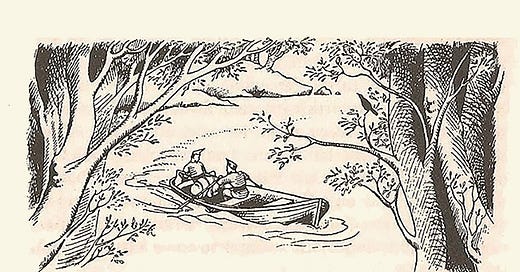As we discuss Prince Caspian, you’ll find some background information about the book and C.S. Lewis in the Inspiration section available to all subscribers. Paid subscribers have access to the more specific discussion in the Application section.
Inspiration of “The Dwarf”
A coin toss between C.S. Lewis and J.R.R. Tolkien in 1936 could’ve led to a very different literary reality for the two Inklings.
Looking out over the literary landscape, Lewis came to Tolkien with an idea. “Tollers, there is too little of what we really like in stories,” Tolkien says Lewis told him. “I am afraid we shall have to try and write some ourselves.” At this point, Tolkien had published The Hobbit, and Lewis’ only work of fiction up to this point was The Pilgrim’s Regress.1
But the coin toss determined that Tolkien was to write a time-travel story and Lewis a space-travel one. Tolkien’s story, as was often the case, fizzled out. His attempt, The Lost Road, was meant to connect Middle Earth and the modern day. It was published posthumously as an unfinished story by his son Christopher in a collection of other works.
For his part, Lewis quickly wrote Out of the Silent Planet, which was published in 1938. Lewis enjoyed science fiction. Two of his favorite authors growing up were H.G. Wells and Jules Verne. But he recognized much of those genre stories were stepped in naturalism, particularly Last and First Men by Olaf Stapledon. Lewis even heard one of his atheist students speak about humans surviving by planet jumping forever, conquering worlds across the galaxy. This horrified Lewis and further encouraged him to use the vehicle of space science fiction to advance a different view of humanity and the universe.
Lewis didn’t stop with just one space travel story. He completed an entire trilogy, but in the middle, he also began his version of a time travel story. The Dark Tower is an unfinished story, which Lewis began around 1939, and possible sequel to Out of the Silent Planet. The manuscript begins with Ransom, the main character of the trilogy, and several others discussing time travel. The fragment of the story came from writings rescued from a bonfire, according to Lewis’ friend and editor Walter Hooper.2
“Tollers, there is too little of what we really like in stories. I am afraid we shall have to try and write some ourselves.” — C.S. Lewis to J.R.R. Tolkien
It is entirely plausible that Lewis recognized his perfectionist friend Tolkien would never get around to completing his story, so Lewis would try his hand at a time-travel tale. Of course, Lewis never finished his version either and moved on to Perelandra as the sequel. Still, you can see the concept of time interested both Lewis and Tolkien, even if neither ever completed a full story about traveling through time.
Portions of Tolkien’s attempt eventually made their way into The Lord of the Rings legendarium, including the fall of Númenor. He also deals with time moving differently in different areas of Middle Earth, especially in the lands of the elves like Lothlórien.
For his part, Lewis describes Merlin as living in a different time than our own in That Hideous Strength. And, most pertinent to this discussion, he incorporated different flowing of time for Narnia and Earth. While the Pevensies experience those differences in the first book, they mostly experienced it from the Narnia side. They grew up in Narnia and became adults only to return to Earth the same age they were when they left. But now in Prince Caspian, they’re experiencing the other side, returning to Narnia after seemingly thousands of years have passed.
As Edmund explains in chapter three: “[O]nce you’re out of Narnia, you have no idea how Narnian time is going. Why shouldn’t hundreds of years have passed in Narnia while only one year has passed for us in England?”
Narratively, this allowed Lewis to condense the entire timeline of Narnia into his lifespan on Earth, but it served an additional apologetic function. Remember, Lewis has said he wrote the books as an effort to “sneak past the watchful dragons” and smuggle some theological insight through the fantastical. This smooths the path for children (and us) to think about God and time.
Keep reading with a 7-day free trial
Subscribe to The Wardrobe Door to keep reading this post and get 7 days of free access to the full post archives.





